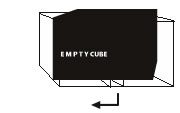DANIEL BARROCA
JUNE, 18, 2008

CONTACT
barrocadaniel@gmail.com
EXHIBITION INFORMATION
Lento/Slow, 2008
Ink-jet text and dvd pal, b&w, loop, Poem translated by Pedro Moura
The distention of silence.
How does one speak of a face being fondled or a head in motion that drags with it a body that has indefinitely gone astray? What sound encroaches on this figure, draining the room we find ourselves in?
There are no likely answers to these questions, just the impossibility Daniel Barroca confronts and simultaneously places before us. "Lento/Slow" is a work that has as its inception an untitled poem of the artist’s own invention. This is not an "Untitled" poem, rather a fragment extracted from the artist’s daily interaction with space and echoes and murmurs that pervade his lodgings and surroundings. This piece by Daniel Barroca was produced in Berlin, in his studio, situated within the Kunstlerhaus Bethanien edifice, where he has been working for almost a year.
With this experience, viewers meet up with a doubt, namely how to identify the sounds that reach us from outside, noises that emerge as autonomous, encircling beings which transport us to the presence of possible world. In the first instance, this is like recognizing that solitude awakens individual awareness, a tibial connection to the seemingly repetitive stimuli we replicate, automatically in order to attain the absent other. So that in the breadth of silence, deafened voices may surface, resonating amongst each other, generating a kind of labyrinth which occupies and distends itself within the space we too occupy. And which too invades us.
When first approaching this work by Daniel Barroca, viewers distinguish the human figure, but this does not serve to confine the video. Instead, this re-visitation begins with a text that adopts a universal dimension as the second part of the poem is read:
in order to state what you yourself are
what the world is.
Barroca undertakes a path that triggers the "unheimlich". He follows a Beckettian lineage in the sense that these utterances are directed towards a second person. An other, besides oneself, who becomes an unconditional you, potentially anyone, impregnated with the power the written word confers to the construction of the world and thought. But there is also a haunting drone to the sounds that surround us, like the persistent ring of a bell over the distance that separates us from the world and our indomitable desire to return to it. This chime calls to mind Andrei Tarkovski’s "Andrey Rublyov" of 1969, a sublime evocation of artistic creation as the sole possibility of return, of reengaging with the world and, in this, with life. Barroca exposes his viewers to an extreme through the arresting image of a face devoid of a gaze, the remainder of a human figure, dampened by the pendular sound of bells or an echo without a referent. This image, removed from the familiar, moves steadily, as if out of time, revealing an incessant instability. This deceptive portrait returns indefinitely by way of dark intervals, like a syncopated luminescence, signaling the transitoriness of life. This black and white video relates not only to other previous video works by the artist, but to his practice of drawing, which does not rest in repetition, but in doggedly looking for a response by pursuing resistance, the same movements, the same hiatuses, the same circularity that transforms an elliptical curve and unveils another apparently external pursuit, absence. The distant sound we hear cautions us to our distance from the world and our detachment, it cautions us to the immediacy and diverse figurations that cheat us of our awareness of time, and the fast protagonism that we embrace as the highest from of action, one that falsifies our capacity to capture detail and distinguish an infinitesimal sound or decipher the layers employed in the fabrication of silence.
João Silvério
Junho 2008




